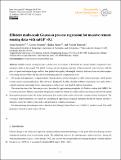Efficient multi-scale Gaussian process regression for massive remote sensing data with satGP v0.1
Author(s)
Susiluoto, Jouni; Spantini, Alessio; Haario, Heikki; Marzouk, Youssef
DownloadPublished version (14.58Mb)
Publisher with Creative Commons License
Publisher with Creative Commons License
Creative Commons Attribution
Terms of use
Metadata
Show full item recordAbstract
<jats:p>Abstract. Satellite remote sensing provides a global view to processes on Earth that has unique benefits compared to measurements made on the ground. The global coverage and the enormous amounts of data produced come, however, with the price of spatial and temporal gaps and less than perfect data quality. Meaningful statistical inference from such data requires overcoming these problems and that calls for developing efficient computational tools. We design and implement a computationally efficient multi-scale Gaussian process (GP) software package, satGP, geared towards remote sensing applications. The software is designed to be able to handle problems of enormous sizes and is able to compute marginals and sample from a random process with at least over hundred million observations. The mean function of the Gaussian process is described by approximating marginals of a Markov random field (MRF). For covariance functions, Matern, exponential, and periodic kernels are utilized in a multi-scale kernel setting to describe the spatial heterogeneity present in data. We further demonstrate how winds can be used to inform the covariance kernel formulation. The covariance kernel parameters are learned by calculating an approximate marginal maximum likelihood estimate and this is utilized to verify the validity of the multi-scale approach in synthetic experiments. For demonstrating the techniques above, data from the Orbiting Carbon Observatory 2 (OCO-2) satellite is used. The satGP program is released as open source software.
</jats:p>
Date issued
2019Department
Massachusetts Institute of Technology. Department of Aeronautics and AstronauticsJournal
Geoscientific Model Development Discussions
Publisher
Copernicus GmbH